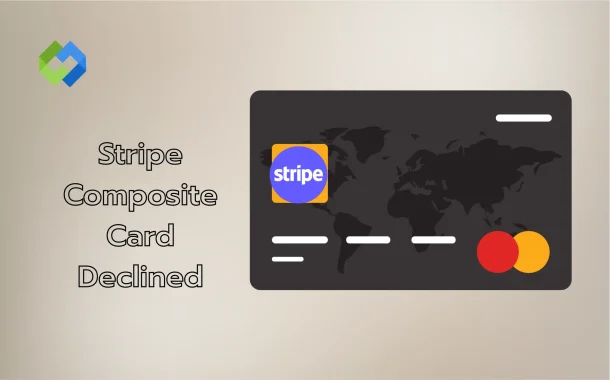You’ll also learn why many businesses prefer using composite cards for their payments. We’ll cover how Stripe processes these cards, what can cause a transaction to be declined, and how to handle such issues. Whether you’re new to Stripe or looking to improve payment success, this guide will give you the clarity you need.
Table of Contents
Table of Contents
What is a Composite Card Declined
A Composite Card Declined message in Stripe means the payment was unsuccessful. A composite card is a special type of virtual card. It pulls money from more than one funding source, like different bank accounts or wallets. These cards are mostly used by businesses for better control over spending.
When a transaction fails, Stripe shows a decline message. This usually means something went wrong while processing the payment. The decline can happen for many reasons. It could be due to incorrect card information, low funds, or restrictions set by the bank or payment provider.
Stripe has systems to detect risks and block suspicious payments. Sometimes, a valid transaction gets blocked if it looks risky. Also, if any one of the funding sources in the composite card has a problem, the entire transaction can fail.
Common Reasons for Declines
Incorrect Card Information
One of the most common reasons for a decline is wrong card details. If the card number, expiry date, or CVC code is incorrect, Stripe will not process the payment. Even small mistakes during entry can lead to a failed transaction.
Insufficient Funds in Linked Accounts
Composite cards use multiple funding sources. If any one of these sources has low or no balance, the payment can be declined. Stripe checks all linked accounts, and a failure in just one can stop the full transaction.
Bank or Issuer Restrictions
Sometimes, the customer’s bank blocks the payment. This may happen due to spending limits, security rules, or location-based restrictions. Large or unusual payments often trigger these blocks, especially for international transactions.
Stripe’s Fraud Detection System
Stripe has strong security tools to stop fraud. If a payment looks risky or suspicious, it can be declined automatically. This happens even when the card details are correct. It helps protect both the business and the cardholder.
Troubleshoot a Declined Composite Card
Check the Card Information
Start by reviewing all the card details entered during checkout. This includes the card number, expiry date, CVC code, and billing address. Even a small typo can lead to an instant decline. Ask the customer to re-enter their card information carefully. If the card is saved on file, try removing and re-adding it.
Ask the Customer to Contact Their Bank
If the details are correct, the issue might be on the bank’s side. The customer’s bank may block the payment due to security rules, unusual activity, or spending limits. Ask the customer to call their bank and confirm if they are allowing the transaction. In many cases, once the bank approves it, the payment will go through on retry.
Review Stripe Dashboard for Decline Codes
Stripe provides clear reasons for each failed payment in your Dashboard. Go to the “Payments” section and open the declined charge. You’ll see a decline code like insufficient_funds, do_not_honor, or fraudulent. These codes help you understand what went wrong. Use Stripe’s support documentation to look up the meaning and possible fixes for each code.
Adjust Stripe Radar or Security Settings
Stripe Radar helps stop fraud but sometimes blocks valid payments too. If you notice many false declines, your Radar rules might be too strict. Review your settings in the Stripe Dashboard. You can lower the fraud threshold or add safe email domains and card numbers to your allowlist. This helps reduce unnecessary declines while keeping your account secure.
Preventing Future Declines
Enable 3D Secure or Strong Customer Authentication
3D Secure adds an extra layer of security during checkout. It asks the customer to verify their identity using a code or app. This step reduces fraud and increases the chances of approval. In some regions, it’s required by law. Enabling it in Stripe helps reduce declines, especially in Europe or with high-risk payments.
Use Real-Time Validation on Checkout
Always validate card details as the customer types them. This helps catch mistakes early. Stripe’s built-in checkout tools support real-time validation. It ensures the card number, expiry date, and CVC are formatted and entered correctly. This reduces errors and improves the approval rate.
Set Up Clear Payment Error Messaging
If a payment fails, tell the customer why in simple words. Show a clear message like “Card declined—please check your bank” instead of a generic error. This helps them fix the issue faster. You can use Stripe’s decline codes to show custom messages based on the reason.
Monitor Decline Rates and Patterns
Keep an eye on how often payments fail in your Stripe dashboard. Look for common decline codes or times when it happens more. If you spot a pattern, you can take action—like updating fraud rules, checking for expired cards, or contacting your customer base. Early detection helps prevent future problems.
When to Contact Stripe Support
If your customers are seeing repeated declines and you can’t find a clear reason, it’s time to contact Stripe support. This is especially important if the card details are correct and there are no obvious errors in the dashboard. The support team can check behind the scenes and tell you what’s really going wrong.
You should also reach out if Stripe is blocking real payments from trusted customers. This may happen if your fraud settings are too strict or if Stripe misidentifies a payment as risky. Support can help you adjust these settings or whitelist good customers.
If you see decline codes like do_not_honor, card_not_supported, or generic_decline, and you’re unsure what they mean, contact support. They’ll explain the code and suggest the best way to fix it. Some codes need action from your side, while others require action from the customer’s bank.
Conclusion
A composite card decline in Stripe usually happens due to wrong card details, low funds, or bank restrictions. It can also be caused by fraud checks or strict security settings. Checking the decline code in your Stripe dashboard is the first step to finding the cause.
To avoid future declines, use real-time validation, enable 3D Secure, and review your fraud settings. If issues keep happening, contact Stripe support for help. They can guide you with the exact reason and solution. Keeping your payment system clear and updated can reduce errors and improve success rates.














